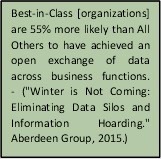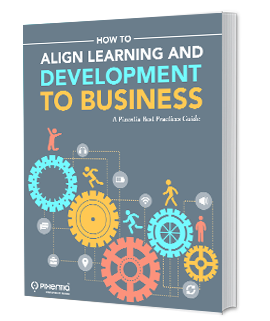
Creating a learning organization takes more than vision. It takes rigorous discipline and measurement to understand the impact of learning. Assessing learning needs, targeting the right training, and measuring the business impact are essential to realizing the value.
The practice of assessing learning needs and delivering targeted training is well established, but the ability to measure business impact is lagging.
The buzz and promise of “big data” have been with us for a few years, and leading organizations are now beginning to realize the value of aggregating operational data with the wealth of information Human Resources creates. Most companies are not yet making the connection. The big data buzz created a heightened demand for better analytics, but the dream has not yet arrived.
The Problem of Data Silos
A 2013 Deloitte Analytics Advantage survey gave us some clues to what is holding analysis back. It shows us some proof of what we have suspected for years: the biggest barrier to improved analytics is organizational silos. Only 12 percent of respondents indicated close coordination across their organizations.

Source: "Analytics Ownership Power Struggles." Deloitte Analytics Advantage Survey, 2013.
Data silos impact business. A 2015 Aberdeen Group study shows us that organizational silos have an adverse effect on people who are trying to use data to make better decisions.
 Source: Silos Damage the User Experience. "Winter is Not Coming: Eliminating Data
Source: Silos Damage the User Experience. "Winter is Not Coming: Eliminating Data
Silos and Information Hoarding." Aberdeen Group, 2015
Bridging the Gap – A Case Study
If your learning organization is going to lead the way to better productivity, you will have to cross organizational barriers.
We have seen in our work how solving a problem for a business unit can pay off when we apply the same rigor to training as we do to other business processes.
A leading auto company needed to improve sales in its North American operations. By analyzing customer feedback data about the sales process in dealerships, the company had pinpointed areas where focused training could improve satisfaction. They worked with us to create a pilot e-learning solution that focused on the specific skills needed to improve the customer experience.
The training itself is a media-rich interactive experience with practice drills based on customer scenarios. At the end of of each module is a looping quiz, in which a 100% correct response to questions is required to exit the loop.
The company then analyzed the sales and customer satisfaction performance of participants in dealerships around the region and compared the data with the control groups who did not receive the training. The outcome measures compared the 10% who received the training with the 90% who did not.
The program clearly established the value of training targeted at specific behaviors. Both sales and customer satisfaction increased after the training.
This case demonstrates that by shifting our thinking from internal training measures to business outcome measures we can show clearly both the need for and the value of learning.
But this doesn’t mean internal training measures aren’t necessary. To make a valid correlation between learning and business outcomes, we need to show that learning took place. Participation, completion, and assessment data are essential to understanding the cause-and-effect relationship.
How to Get Started
Putting all of this together, we can recommend seven essential steps to grow your analytical capability by breaking down barriers.
 Make the first move. Start sharing aggregate assessment data across your organization. Pre- and post- training assessments targeting specific skills will demonstrate clearly that a change has happened. Follow-up reinforcement and assessment data will show that people are employing their new skills.
Make the first move. Start sharing aggregate assessment data across your organization. Pre- and post- training assessments targeting specific skills will demonstrate clearly that a change has happened. Follow-up reinforcement and assessment data will show that people are employing their new skills.- Create alliances. It is quite possible that long-standing silos make conversations difficult. Expect and prepare for it. You may need to start by cultivating a single ally.
- Get into the performance conversation. When people around the organization discuss business challenges, ask how better knowledge, skills, and behavior could help.
- Let your business leaders drive. Bring them into the analysis, decision and design processes. Help them solve their problems.
- Examine the existing performance data to identify the gaps. Expand understanding by talking with the people in the processes.
- Design targeted interactive training. Train to the specific behaviors your people need to change. Measure and report on the internal training measures and assessments.
- Measure the business results. Correlate the training measures with the outcome measures.
We hope this helps you on the way to sharing data across your organizational barriers. Companies that are breaking down data silos achieve better business results. Your company can be one of them.
Pixentia is a full-service technology company dedicated to helping clients solve business problems, improve the capability of their people, and achieve better results.



